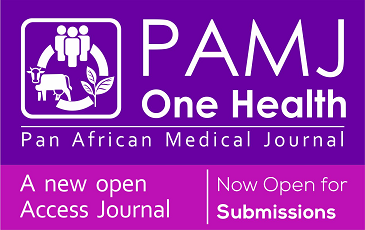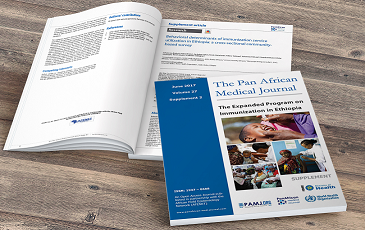Native valve endocarditis due to Legionella pneumophila in intensive care unit: case report and review of the literature
Farah Zouari, Fatma Medhioub, Dorsaf Dlensi, Salma Jerbi, Sahar Ben kahla, Zina Hakim, Wiem Feki, Rania Allala
Corresponding author: Farah Zouari, Intensive Care Department, Regional Hospital of Mahares, University of Sfax, Sfax, Tunisia 
Received: 01 Jul 2025 - Accepted: 21 Aug 2025 - Published: 28 Aug 2025
Domain: Health emergencies,Cardiology,Intensive care medicine
Keywords: Legionella, endocarditis, native valve
Funding: This work received no specific grant from any funding agency in the public, commercial, or not-for-profit sectors
©Farah Zouari et al. PAMJ Clinical Medicine (ISSN: 2707-2797). This is an Open Access article distributed under the terms of the Creative Commons Attribution International 4.0 License (https://creativecommons.org/licenses/by/4.0/), which permits unrestricted use, distribution, and reproduction in any medium, provided the original work is properly cited.
Cite this article: Farah Zouari et al. Native valve endocarditis due to Legionella pneumophila in intensive care unit: case report and review of the literature. PAMJ Clinical Medicine. 2025;18:16. [doi: 10.11604/pamj-cm.2025.18.16.48513]
Available online at: https://www.clinical-medicine.panafrican-med-journal.com//content/article/18/16/full
Case report 
Native valve endocarditis due to Legionella pneumophila in intensive care unit: case report and review of the literature
Native valve endocarditis due to Legionella pneumophila in intensive care unit: case report and review of the literature
![]() Farah Zouari1,&,
Farah Zouari1,&, ![]() Fatma Medhioub1,
Fatma Medhioub1, ![]() Dorsaf Dlensi1,
Dorsaf Dlensi1, ![]() Salma Jerbi1, Sahar Ben kahla2, Zina Hakim3, Wiem Feki4, Rania Allala1
Salma Jerbi1, Sahar Ben kahla2, Zina Hakim3, Wiem Feki4, Rania Allala1
&Corresponding author
Legionella species are primarily linked to pulmonary infections and account for less than 1% of all bacterial cardiac infections. We present a case of infective endocarditis (IE) caused by Legionella pneumophila in an 83-year-old immunocompetent woman, which was complicated by splenic infarction. The patient had no history of cardiothoracic surgery or congenital valve disease. She presented with severe community-acquired pneumonia, most likely caused by atypical germs, which did not improve with appropriate antibiotic therapy. A transesophageal echocardiogram revealed a large abscessed and fistulized vegetation on the mitral valve, while blood cultures were negative. The serology and urinary antigen testing for L. pneumophila confirmed the diagnosis. A six-week cure with an association of rifampicin and clarithromycin was started. A clinical recovery under antibiotic therapy marked the evolution without requiring valve replacement. This case underscores the need for heightened awareness of rare but serious complications, such as endocarditis, in patients diagnosed with Legionella species.
Infective endocarditis of native valves is relatively rare, with an incidence of approximately 2 to 10 cases per 100,000 person-years [1]. Species of Streptococcus and Staphylococcus cause most of these cases. Cases in which negative blood cultures are often attributed to recent use of antimicrobial agents or fastidious bacteria (e.g. Coxiella burnetii, bartonella species, legionella and Tropheryma whipplei) [2]. Reported cases of Legionella endocarditis primarily occur in patients with a history of valve replacement [3]. Endocarditis affecting native valves due to Legionella is extremely rare and often underestimated [4].
Patient information: an 83-year-old woman with no prior medical history presented to the emergency department with asthenia and fever. She complained of vomiting, diarrhea, and epigastric pain, with the notion of dyspnea for 3 days. Patient previously treated with symptomatic medication from a general practitioner without significant improvement. She had no history of cardiothoracic surgery or congenital valve disease.
Clinical findings: she was febrile with a temperature of 40°C, had a heart rate of 126 beats per minute, and her blood pressure was 76/42 mmHg. She also presented with tachypnea at 29 breaths per minute and signs of respiratory distress, along with an oxygen saturation of 81% on room air. The pulmonary examination showed crackling breath sounds in both lung bases. Cardiac auscultation was normal, and no murmurs were detected. She had general abdominal tenderness. The electrocardiogram showed sinus tachycardia. An extensive infiltration of both lungs was seen on chest X-ray. Initial laboratory evaluation revealed a blood leukocyte count of 20300 leukocytes/l (normal range: 4000-10000 leukocytes/l), C-reactive protein (CRP) was highly elevated at 208 mg/l (normal range: < 6 mg/l), and lactates were 3.5 mmol/l. Blood cultures, serology for atypical pathogens, and Legionella urinary antigen test were performed.
Timeline: according to clinical and biological findings, the patient was treated as a septic shock secondary to severe acute community-acquired pneumonia. She was put on empiric antibiotic therapy with an association of cefotaxime, clindamycin, and metronidazole. After 2 days of hospitalization, the patient presented with an escalation of the biological inflammatory syndrome (blood leukocyte count of 29600 leukocytes/l and CRP at 420 mg/l) and clinical stagnation.
Diagnostic assessment: a thoraco-abdominal CT scan was ordered, revealing diffuse opacifications and centrilobular nodules with bilateral minor pleural effusion and splenic infarctions situated on the lower pole (Figure 1). Transesophageal echocardiography revealed a large 18-mm vegetation on the mitral valve, complicated by abscess formation and fistulization, which resulted in significant eccentric severe mitral regurgitation, consistent with infectious endocarditis (Figure 2). The serology for atypical pathogens was positive for L. pneumophila coupled with the Legionella urinary antigen test.
Diagnosis: based on the modified Duke criteria (1 major and 3 minor criteria), the diagnosis of infectious endocarditis with vascular phenomena was established.
Therapeutic interventions: the patient was transferred to the intensive care unit of the cardiology department. The antibiotic therapy was switched to rifampicin and clarithromycin for 6 weeks without requiring a valvular replacement.
Follow-up and outcome of interventions: at follow-up, the patient was well and asymptomatic.
Patient perspective: “Since I've been taking this new medication, I've started to feel better, with improvements in asthenia and dyspnea.”
Informed consent: the patient and family were informed about the case reported and agreed that the case would be published for the benefit of people and medicine.
Epidemiology: Legionella spp. comprises more than 50 species of aerobic or facultative intracellular Gram-negative bacilli. Legionella pneumophila is the most commonly implicated species in humans, with serogroup 1 being the most frequent and virulent [5]. The established method of transmission in humans involves inhaling infectious aerosols that originate from aquatic environments. Legionella spp. is associated with both community-acquired and nosocomial pneumonia. It is rarely associated with extrapulmonary manifestations, notably infective endocarditis [6]. Twenty-three cases of Legionella endocarditis were reported in the literature, with the earliest case dating back to 1984 [7,8] (Annex 1). Extra-pulmonary manifestations can be found, especially in immunocompromised patients, and are considered a consequence of hematogenous spread from the lung [6,9]. In the majority of cases, Legionella endocarditis often occurs in patients with a valvular prosthesis or following cardiothoracic surgery [3,6]. Native valve endocarditis due to Legionella is rarely described; only 6 cases have been reported in the literature [7]. Our case represents the fourth instance of native valve endocarditis caused by Legionella pneumophila. Our patient is immunocompetent and presents with pneumonia upon admission.
Diagnosis: Legionella endocarditis typically presents with a subacute onset. It may be associated with pulmonary infection or delayed for up to several weeks [6]. When fever is present, it is usually low-grade. Weight loss and anemia may be present. Cardiac failure and chest pain have been noted, while embolic and immunologic phenomena have been rare [6]. In the literature, 2 reported cases represented bacterial dissemination to the central nervous system, and 1 reported digital microembolisms [7]. One case of Legionella endocarditis was reported with septic arthritis and only 1 case with splenic infarction [2]. The diagnosis of Legionella endocarditis can be difficult, as blood cultures are often negative and echocardiography often does not show any vegetations [6]. Serological tests for anti-Legionella antibodies were positive in 13 cases. The urinary antigen test for Legionella pneumophila was positive in only 2 of the 6 cases. Four had a diagnosis made based on PCR technique and sequencing from valve tissue [7,8] (Annex 1). In our case, the diagnosis of native valve endocarditis due to Legionella was made based on modified Duke criteria [1], fulfilling 1 major criterion by the presence of vegetation on the mitral valve, and 3 minor criteria: fever (temp > 38°C), vascular phenomena (splenic infarction), and microbiologic evidence (positive urinary antigen).
Treatment: once Legionella endocarditis is diagnosed, treatment should be initiated immediately. Antibiotic therapy based on intravenous levofloxacin or the combination of clarithromycin and rifampicin is recommended, following the latest guidelines [10]. There are currently no valid recommendations regarding the optimal duration of treatment. Therapeutic regimens range from six weeks for native valves to 5-14 months for valvular prostheses, as reported in the literature (Annex 1).
In situations of culture-negative endocarditis, potential causative organisms should include Legionella species, particularly in rare cases involving native valves, such as in our case. Embolic phenomena in Legionella endocarditis are infrequent but have been reported. Diagnosis is often difficult due to a non-specific clinical presentation and the need for clinical suspicion to appropriately guide microbiological testing. Nevertheless, when identified and treated appropriately, Legionella endocarditis is curable.
The authors declare no competing interests.
All the authors have read and approved the final version of this manuscript.
Figure 1: thoraco-abdominal CT scan showing focal lower pole splenic infarctions
Figure 2: transesophageal echocardiogram at 140 degrees with the long axis cut centered on the mitral valve, showing an image of vegetation measuring 1.86 x 1.15mm on the atrial side of the small mitral valve; LA: left atrium, LV: left ventricular, AO: aorta
Annex 1: main characteristics of patients from the cases of Legionella endocarditis (PDF - 153 KB)
- Chambers HF, Bayer AS. Native-Valve Infective Endocarditis. N Engl J Med. 2020 Aug 6;383(6):567-576. PubMed | Google Scholar
- Baumgartner VA, Eich G, Christen S, Chmiel C. Legionella native valve endocarditis case report and review of literature. International Archives of Medicine. 2016;9(14):1-6. Google Scholar
- Samuel V, Bajwa AA, Cury JD. First case of Legionella pneumophila native valve endocarditis. Int J Infect Dis. 2011;15(8):e576-7. PubMed | Google Scholar
- Young JS, Farber BF, Pupovac SS, Graver LM. Prosthetic Valve Legionella Endocarditis. Ann Thorac Surg. 2019;108(4):e271-2. PubMed | Google Scholar
- Burillo A, Pedro-Botet ML, Bouza E. Microbiology and Epidemiology of Legionnaire´s Disease. Infect Dis Clin North Am. 2017;31(1):7-27. PubMed | Google Scholar
- Brusch JL. Legionnaire´s Disease: Cardiac Manifestations. Infect Dis Clin North Am. mars 2017;31(1):69-80. PubMed | Google Scholar
- Teira A, Sánchez J, Santiago I, Zarauza J, Nan D, Teira R. Legionella endocarditis: A case report and review. Enfermedades Infecc Microbiol Clin Engl Ed. avr 2022;40(4):190-4. PubMed | Google Scholar
- Fraz MSA, Dahle G, Skaug KM, Jarraud S, Frye S, Bjørnholt JV et al. Case report: A prosthetic valve endocarditis caused by Legionella bozemanae in an immunocompetent patient. Front Med (Lausanne). 2022 Nov 3:9:1055465. PubMed | Google Scholar
- Cattan S, Thizy G, Michon A, Arlet JB, Lanternier F, Lebeaux D et al. Actualités sur les infections à Legionella. Rev Médecine Interne. 2019;40(12):791-8. PubMed | Google Scholar
- Habib G, Lancellotti P, Antunes MJ, Bongiorni MG, Casalta JP, Del Zotti F et al. 2015 ESC Guidelines for the management of infective endocarditis: The Task Force for the Management of Infective Endocarditis of the European Society of Cardiology (ESC) Endorsed by: European Association for Cardio-Thoracic Surgery (EACTS), the European Association of Nuclear Medicine (EANM). Eur Heart J. 21 Nov 2015;36(44):3075-128. PubMed | Google Scholar






